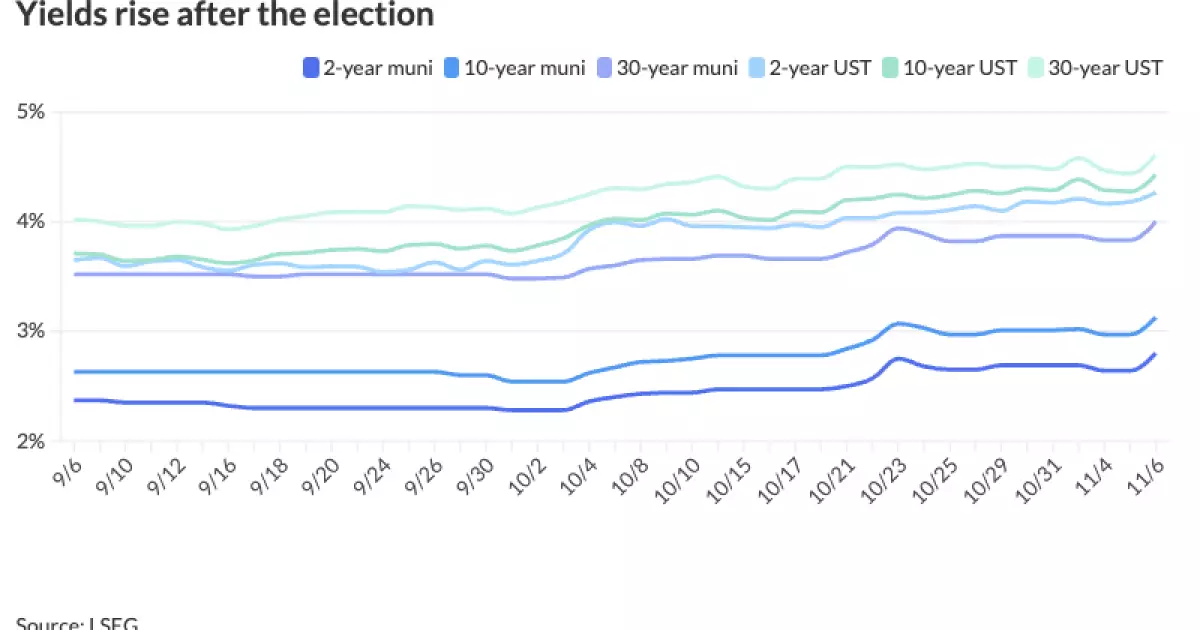The fervor surrounding political elections has always been a significant driver in financial markets, particularly within the realm of municipal bonds. Recent events highlighting a substantial Republican victory in both the presidential and Senate races have resulted in considerable shifts in the bond market landscape. The consequences of these developments are multifaceted, influencing municipal bonds’ yields, the relationships with U.S. Treasuries (UST), and investors’ sentiments towards fiscal policy changes.
On the day following the electoral outcome, municipal bonds reacted sharply, mirroring the behavior of UST. The sell-off was orchestrated by increased yields across the spectrum, fostering a pronounced risk-on mentality among investors. Such a reaction is reflective of the fundamental principles in fixed-income markets, where yields are inversely related to the price of bonds—the expectation of higher yields translates into falling prices for municipal bonds. Specifically, the yield curve for triple-A rated municipal securities escalated by a notable range of 11 to 17 basis points, indicating a broader sell-off. The increase in yields served as a harbinger of the anticipated changes in fiscal policies under a Republican majority, which are traditionally characterized by tax cuts and increased spending, thus contributing to the fears of inflation and higher interest rates.
Market Dynamics and Municipal-UST Ratios
With the shifting focus towards fiscal conservatism, the ratios between municipal yields and UST yields drew significant attention from market analysts. As of the recent data compiled, the notable variations spanned from 64% for three-year municipal bonds to 87% for 30-year ones. This rise in ratios illustrates the widening spread between municipal bonds and UST. The implications are manifold, indicating increased risk premiums demanded by investors in the face of growing fiscal uncertainties. The discussions among strategists emphasized the expectation that municipal bonds would continue to follow UST movements, with the degree of sell-off closely tied to the flow of municipal exchange-traded funds.
The aftermath of the election results has positioned the market to reevaluate the upcoming economic landscape with trepidation. Peter Block, the managing director of credit strategy at Ramirez, poignantly remarked on the shockwaves sent through the markets, even amidst anticipation of a Trump victory. The sentiment reflects the market’s fragile confidence, where unexpected outcomes can lead to significant volatility. BMO Capital Markets’ economic research has pointed out the dual impact of anticipated growth and inflation, wherein higher economic growth forecasts lead to real yields climbing, compounded by inflationary pressures resulting from expansive fiscal policies.
Investors’ focus has shifted towards how these anticipated fiscal policies might manifest, including heightened deficits that could constrain future growth. The prospect of major infrastructure projects underpins discussions regarding the tax-exempt municipal market, which may see an influx of supply due to increased government spending. As these projects come into focus, a nuanced demand pattern may emerge, further affecting the yields and prices in the municipal bond market.
The broader narrative envelops the expected actions of the Federal Reserve (Fed) as it gears for a potential rate cut amid evolving economic conditions. Analysts project a possibility of the Fed reducing its key interest rate by 25 basis points, suggesting a more accommodative policy to support economic growth. However, there’s also caution against overzealous easing, particularly in light of potential inflationary pressures from impending tax cuts. The Fed’s considerations revolve around a delicate balancing act between stimulating the economy and managing inflation.
Mark Dowding from BlueBay asserts that while there might be a single rate cut soon, the Fed may choose to pause following that move, aligning its strategy with ongoing economic indicators. This reflects a broader concern among economists about responding to emerging inflation dynamics spurred by fiscal expansion and the pressures of new tariff policies, especially as they relate to international trade relationships with countries beyond China.
The municipal bond market is at a critical juncture, influenced heavily by political shifts and impending fiscal policies. Investors are acutely aware of the implications of heightened yields, altered municipal to UST ratios, and the potential action from the Federal Reserve. As they navigate this uncertain landscape, the focus remains attuned to how these dynamics will ultimately shape both the short-term and long-term prospects for municipal bonds. Understanding the interplay among these factors is paramount for investors aiming to make informed decisions in an evolving financial ecosystem.


Leave a Reply